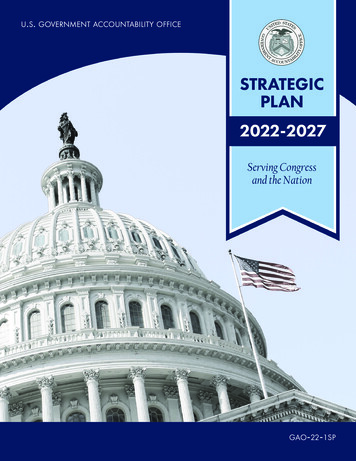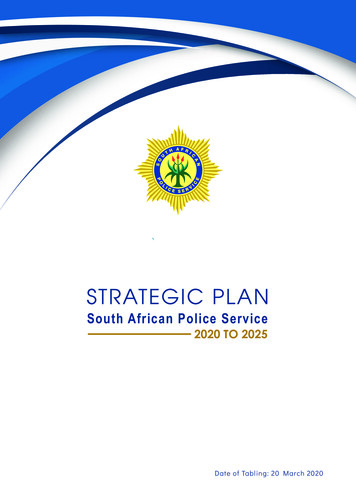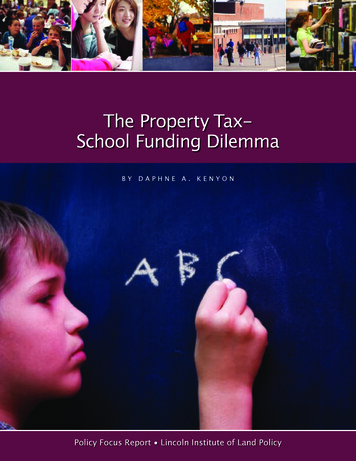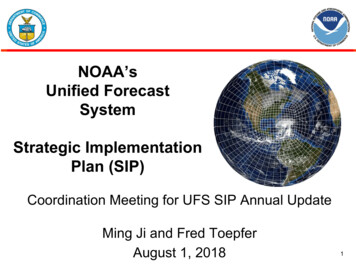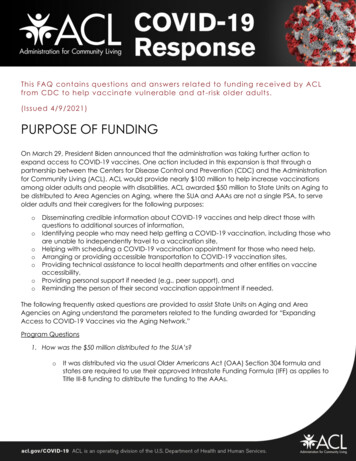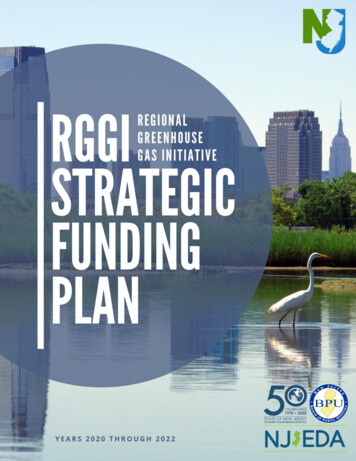
Transcription
RGGI Strategic Funding Plan:Years 2020 through 2022RGGI STRATEGIC FUNDING PLANYears 2020 through 2022ContentsIntroduction and Background . 2Public Engagement & Priorities . 3RGGI Proceeds Distribution: Legal and Regulatory Framework . 5RGGI Funding Initiatives (2020 through 2022) . 7Initiative One: Catalyze Clean, Equitable Transportation . 8Initiative Two: Promote Blue Carbon in Coastal Habitats. 12Initiative Three: Enhance Forests and Urban Forests . 14Initiative Four: Create a New Jersey Green Bank. 16Priority Ranking Summary. 19Anticipated Co-Benefits . 20Appendix A: Guidelines for the Objectives . 211Cover Photo Courtesy of Jonathan Luk, Superintendent, NJ State Park Service
RGGI Strategic Funding Plan:Years 2020 through 2022Introduction and BackgroundNew Jersey will invest its Regional Greenhouse Gas Initiative (RGGI) auction proceeds in programs and projectsdesigned to help meet the State’s climate, clean energy and equity goals. The RGGI Strategic Funding Plan: Years2020 through 2022 (hereafter referred to as the Plan) will support Governor Phil Murphy’s commitment to reducinggreenhouse gas emissions and vision for transitioning the state to 100% clean energy by 2050. The Plan identifiesinitiatives that will be funded by RGGI auction proceeds and how these investments complement emissionsreductions, clean energy, and environmental justice priorities. While supporting transformational changes in energysystems that are necessary to avoid further adverse impacts from climate change, these strategic investments willalso support New Jersey communities that have been disproportionately impacted by pollution, improving theirenvironmental conditions and ensuring that they have equal access to the clean energy economy.The Murphy Administration acknowledges that this Plan is being issued at a time of upheaval and economicuncertainty, as the novel coronavirus (COVID-19) outbreak has disrupted our lives and economy. The pandemic hasalso highlighted the inextricable link between public health and economic development, a relationship that drives theMurphy Administration’s efforts to reduce the public health risks from pollution and climate change while buildingupon New Jersey’s innovation economy. As we work to ensure that our economy recovers from this pandemic,supporting initiatives that promote health, equity, and environmental protection will promote a stronger and fairerNew Jersey. The initiatives in this Plan are a roadmap for reducing greenhouse gas emissions, improving healthoutcomes, creating jobs and accelerating New Jersey’s economic recovery. While improving air quality and reducingthe public health and economic risks from climate change, the investments this Plan will make in the State’s cleanenergy economy will strengthen main street businesses and spark high-quality job growth.This Plan covers a three-year period, from 2020 through 2022. The New Jersey Department of EnvironmentalProtection (NJDEP), the New Jersey Economic Development Authority (NJEDA), and the New Jersey Board of PublicUtilities (NJBPU), are designated by law to distribute RGGI proceeds. The Plan also coordinates the initiatives acrossagencies to ensure their overall effectiveness in meeting New Jersey’s greenhouse gas reduction, clean energy, andequity goals. The Plan also ensures cross-agency collaboration to leverage funding in support of other statewidestrategic efforts, including those identified in the State Economic Development Plan, the Energy Master Plan, and theElectric Vehicle Law. Finally, although a new funding plan is required every three years, the agencies may revisit thisPlan sooner, and each subsequent funding plan will summarize project and program spending and results achievedduring the prior strategic funding period.2
RGGI Strategic Funding Plan:Years 2020 through 2022Public Engagement & PrioritiesThis Plan reflects the thoughtful public input that wascollected in the fall of 2019. Prior to the start of thepublic input period, the NJDEP, NJEDA and NJBPU jointlyreleased the RGGI Auction Proceeds Scoping Document,designed to provide stakeholders with a commonunderstanding of the legal and regulatory frameworksurrounding the distribution of the RGGI auctionproceeds. The scoping document identified the specificlegal and regulatory requirements underpinning thedevelopment of the Plan; funding priorities for the firstPlan; and illustrative examples of potential fundinginitiatives. Throughout November and December of2019, the agencies took turns hosting four publicworkshops and one webinar to gather public input. Theworkshops were hosted at various locations throughoutthe State and at various times of day, in both cases inorder to help ensure participation by a diverse crosssection of the New Jersey public. In addition, theworkshops utilized various methods to collect feedbackfrom the public, including dot voting, a question andanswer period and facilitated breakout sessions. TheRGGI Strategic Funding Plan Public Workshops were held across thestate to capture a diverse cross-section of the public.public also submitted feedback via a dedicated emailaddress. The materials from each workshop, as well as arecording of the webinar, are posted on the State’s RGGI website at www.nj.gov/rggi/.In total, nearly 200 individuals representing a diverse array of organizations and areas of interest, includingmunicipalities, unions, environmental groups, environmental justice communities, transportation planning, energyuse, and natural resources conservation and use, attended the four workshops or participated in the webinar event.In addition, the agencies received over 30 comments via email. Overall, participants expressed general support for allthe example initiatives in the scoping document, with the clean transportation and blue carbon initiative examplesbeing assigned the highest priority by most stakeholders. Participants were highly engaged, asking clarifyingquestions about each initiative and offering suggestions for improvements and possible additional programs andprojects that could be funded under each example initiative.190 INDIVIDUALSREPRESENTINGDIVERSE INTERESTSATTENDED THE RGGISTAKEHOLDER EVENTSNovember 25, 2019 the NJEDA hosted a RGGI Strategic Funding Plan Stakeholder Meeting at Rutgers University, College Ave Student Center.3
RGGI Strategic Funding Plan:Years 2020 through 2022The agencies reviewed and took account of all the public comments, aligning them with the initial overarching prioritiespresented in the scoping document to provide meaningful benefits to communities most affected by pollution andclimate change; and to catalyze the electrification of the various modes of transportation in the State.Since the beginning of 2020, significant state actions have taken place that provide additional guidance on RGGIproceeds should be invested. These include: Governor Murphy’s January 17, 2020 signing of landmark legislation to boostelectric vehicles in New Jersey. Specifically, the law sets aggressive goals forNew Jersey electric vehicle sales and public charging stations; requires theestablishment of rebates for electric vehicle purchases; and directs the stategovernment to lead by example by electrifying its own fleet. This law alsomodified the Global Warming Solutions Fund Act to allow NJBPU to spend itsRGGI funds to support the plug-in electric vehicle goals established in the law.The January 27, 2020 release of a comprehensive Energy Master Plan thatincludes rigorous goals and spans multiple sectors and governmental agencies.The Energy Master Plan defines “100% clean energy by 2050” to mean 100%carbon-neutral electricity generation and maximum electrification of thetransportation and building sectors to meet or exceed the Global WarmingResponse Act’s (GWRA) 2050 emissions reduction limit. Energy systemmodeling conducted for the Energy Master Plan found that New Jersey cancost-effectively reach its goals of 100% clean energy and reduce itsgreenhouse gas emissions below the GWRA limit largely through electrifyingthe transportation and building sectors, promoting energy efficiency, andmeeting more than a doubling of load growth with 94% carbon-free electricity(the remaining 6% can be provided with carbon neutral electricity, such asbiogas).Governor Murphy’s January 27, 2020 Executive Order 100 (2020), directing theadoption of NJ Protecting Against Climate Threats, or NJ PACT, a suite of rulesto establish greenhouse gas monitoring and reporting and reduce emissions ofcarbon dioxide and, where necessary, short-lived climate pollutants (e.g., black carbon, hydrofluorocarbons andmethane).These three actions, taken together, paint a clear picture of the steps New Jersey will initially prioritize to reducegreenhouse gas emissions in order to attain its 2050 GWRA limit of 80% from 2006 levels by 2050. In addition, they areall, in effect, directives for state agencies to align their resources towards the transformation of New Jersey’stransportation sector, with a focus on benefits in environmental justice areas. Given the scope of their collectivemandates, it is clear that these ambitions cannot be achieved using State resources alone; New Jersey must find ways toalign and leverage private sector funding to support the State’s clean energy transformation.4
RGGI Strategic Funding Plan:Years 2020 through 2022RGGI Proceeds Distribution: Legal and Regulatory FrameworkIn 2008, the Legislature passed P.L. 2008, c. 340, commonly referred to as the Global Warming Solutions Fund Act,which enabled the state to participate in a CO2 emission trading program and established specific state agencyfunding allocations and programmatic areas of focus. Funding is allocated by percentage to three state agencies (60%to the NJEDA, 20% to NJBPU and 20% to the NJDEP), and those agencies are required to spend funds within specificprograms areas. These agency “funding lanes” set clear boundaries about each agency’s target funding recipients andwhat their agency’s proceeds can fund.SUMMARY OF AGENCY FUNDING LANESProjects and programs receiving monies under a sponsored initiative must align with the distributing agency’sprogrammatic requirements. However, the agencies have discretion in the level of funding they can devote to specificprojects and programs and are not required to fund all the program types prescribed by the Global WarmingSolutions Fund Act. For example, while the Global Warming Solutions Fund Act lists five types of programs that NJEDAcould fund, the NJEDA could decide to sponsor initiatives in a given Plan that support only two of those program typesand split their funding between those two initiatives. Each state agency that receives an allocation from the Fundmust sponsor one or more of the initiatives in the Plan.5
RGGI Strategic Funding Plan:Years 2020 through 2022The NJDEP’s Global Warming Solutions Fund Rule defines an initiative as “a funding strategy predicted to advance one ormore of the objectives1 listed in N.J.A.C. 7:27D-2.2, which the agencies have identified as critical.” In layman’s terms,initiatives are broad areas of focus that seek to strategically address a well-defined issue or need and advance one ormore of the six objectives defined in the Global Warming Solutions Fund Rule. The State agencies must rank Planinitiatives against these six objectives.SIX OBJECTIVES DEFINED IN THE GLOBAL WARMING SOLUTIONS FUND RULE1. A net reduction in greenhouse gas emissions or a net sequestration of carbon;2. Significant reductions in greenhouse gas emissions, reduction of impacts on ratepayers, and a significantcontribution to the achievement of the State’s 2050 Global Warming Response Act limit, relative to thecost of the project or program;3. Reduction in energy use;4. Be directly responsive to the recommendations submitted by the Department to the Legislaturepursuant to the Global Warming Response Act;5. Provide co-benefits; and6. Be directly responsive to the negative effects on human health and the environment in communities thatare disproportionately impacted by the effects of environmental degradation and climate change.Specifically, every initiative in the Plan must rank the importance of each objective as either “critical” or “beneficial”where critical means necessary, and beneficial means tending to help, but not necessary. In addition, each of these sixobjectives must be ranked critical to at least one of the initiatives, and together, the initiatives in the Plan must rankevery objective critical. Appendix A outlines the state agencies’ guidelines for the objectives, providing insight into howthe agencies will interpret the language of the objectives when making their ranking determinations. To learn moreabout the objectives, see Appendix A and review the RGGI Auction Proceeds Scoping Document.1See Appendix A: Guidelines for the Objectives6
RGGI Strategic Funding Plan:Years 2020 through 2022RGGI Funding Initiatives (2020 through 2022)The NJDEP, NJEDA and NJBPU will fund four initiatives during the first three-year RGGI funding period. Funding will bedevoted to programs and projects that fall within the scope of:1.2.3.4.Catalyzing Clean, Equitable Transportation;Promoting Blue Carbon in Coastal Habitats;Enhancing Forests and Urban Forests; and,Creating a New Jersey Green Bank.Each agency must sponsor (i.e., provide RGGI funds for programs or initiatives within) at least one initiative. All threeagencies will sponsor Initiative 1: Catalyze Clean, Equitable Transportation. They will collaborate to accelerate thetransition to electric transportation throughout the state, with a focus on environmental justice communities. TheNJDEP is also sponsoring Initiative 2: Promote Blue Carbon in Coastal Habitats, and Initiative 3: Enhance Forests andUrban Forests. These two initiatives will focus on protecting and enhancing the State’s natural resources, to ensuretheir continued role in sequestering carbon. Finally, the NJEDA will sponsor Initiative 4: Creation of a New JerseyGreen Bank. This initiative will help drive improved energy efficiency and renewable energy uses in the industrial,commercial and institutional sectors.These four initiatives were selected taking account of the directives of the three core 2020 state actions discussedabove; previous funding priorities; the legislative mandates of the Global Warming Solutions Act; and public feedbackcollected during the 2018 RGGI rulemaking process as well as the November-December 2019 public stakeholderengagement process described above. They meet the agency-specific requirements, have at least one objectiveranked critical, and are supported by data and research showing programs and projects under these initiatives wouldbenefit the state’s efforts to meet its clean energy and greenhouse gas reduction goals. Each initiative identifies itssponsoring agency or agencies, indicates which objectives are ranked critical or beneficial by the sponsoring agencies;and identifies the information and materials the agencies relied upon in selecting and ranking these initiatives.PERCENTAGE OF FUNDING BY INITIATIVEGreen Bank, 15%Blue Carbon & Forestry, 10%Clean and Equitable Transportation,75%7
RGGI Strategic Funding Plan:Years 2020 through 2022Initiative One: Catalyze Clean, Equitable TransportationInitiative One seeks to accelerate transportation electrification in the State, focusing on reducing emissions fromtransportation sources in communities disproportionately impacted by the effects of environmental degradation andclimate change. The largest source of emissions within the transportation sector is light-duty vehicles (i.e., cars), asdiscussed further below. However, medium- and heavy-duty vehicles are also major sources of emissions, especiallyin environmental justice communities. These sources include modes for transporting people, such as jitneys andbuses, as well as cargo and freight-moving vehicles and other equipment that regularly operate on roads in or arounddisproportionately impacted communities (e.g., sanitation, delivery and drayage trucks) and off-road in these sameareas (e.g., cargo moving equipment at ports and airports).According to the NJDEP’s 2018 Statewide Greenhouse Gas Emissions Inventory, transportation is New Jersey’s largestsource category, producing 42% of greenhouse gas emissions. That is more than double the next source category ofelectricity generation at 19%. As part of the Energy Master Plan development, state agencies partnered with RockyMountain Institute (RMI) and Evolved Energy Research (Evolved) to model and quantitatively assess various pathwaysto achieve State climate and energy objectives. The modeling scenarios were all bound by the policy mandates of100% clean energy and an 80% reduction in greenhouse gas emissions from 2006 levels by 2050. The modelingrevealed that a least-cost energy system in New Jersey that meets the State’s 2050 goals includes electrification ofmost vehicles in the State. The Energy Master Plan builds on these findings by directing the conversion of almost allof New Jersey’s transportation sector to electric power by 2050. Multiple efforts are underway to achieve thisconversion, including the recently announced BPU program to provide rebates for light-duty (passenger) electricvehicle adoption, and Volkswagen settlement funding disbursed by DEP for the deployment in environmental justicecommunities of medium- and heavy-duty electric vehicles. The projects and programs funded under Initiative Onewill complement those existing efforts and accelerate New Jersey’s transition to zero carbon transportation by 2050.The Energy Master Plan modeling showed that although electrification of end-uses for both transportation andbuildings would more than double electricity demand compared to 2020 levels, it would simultaneously reduce finalenergy demand because electric motors (to drive electric vehicles) and heat pumps (for heating of buildings) are farmore efficient than gasoline- or diesel-fueled engines and natural gas-fired heating equipment.8
RGGI Strategic Funding Plan:Years 2020 through 2022The electric vehicle legislation signed by Governor Murphy on January 17, 20202 establishes the following light-dutyfocused goals for New Jersey electric vehicle purchases and public charging stations: 330,000 registered electric vehicles by 2025, increasing to 2 million electric vehicles by 2040.By 2040, 85% of all light duty vehicles sold or leased in the state will be electric.400 fast charging stations at 200 locations along major highways and communities by 2025.The law also establishes goals for charging stations at multi-family homes and hotels. All these requirements align withthe modeling and Energy Master Plan direction for more aggressive strategies to increase electric vehicle adoption.New Jersey ranked second among states in the northeast for electric vehicle sales in 20183, but only 1.5% of newvehicles sold in New Jersey are electric, compared to 2.1% nationwide. New Jersey is currently ranked 14th in the nationin terms of zero-emission vehicles sales (as % of total sales in 2018) and by the end of December 2019 there were 30,017plug-in electric vehicles registered in the state.4 The state ranks 39th in publicly available charging stations (FastChargingand Level 2 Ports) per capita.5 These statistics show the need for focused planning and investment in transportationelectrification to meet the legislative goals.New Jersey’s environmental justice communities are negatively impacted by the current transportation sector in severalways. These communities rely more heavily than others on public transportation, so tailpipe pollution from diesel busesimpacts them both as bus passengers and by living and working in proximity to these bus routes. Even when they drivepassenger vehicles, these tend to be older model year vehicles with higher emissions rates. New Jersey’s urbanneighborhoods are surrounded by major highways and other substantial roadways that are heavily travelled, both bycars and trucks. Finally, the proximity of many of these neighborhoods to the State’s port system, the largest on theEastern Seaboard, brings additional emissions from trucks, most of them diesel-fueled, moving freight in and out of theports, as well as from cargo handling equipment within the ports themselves.Accelerating the use of electrified transportation in and around these communities is key in achieving the state’senvironmental justice goals. JerseyRenews notes in a recent report that developing an electrified transit system can helpclose the health and wealth gap by reducing air pollution and mitigating climate change equitably.6 This initiative’sintention to prioritize transportation solutions in environmental justice areas aligns with the New Jersey EnvironmentalJustice Alliance’s (NJEJA) request for New Jersey to prioritize emission reductions for the parts of the state with thegreatest needs in accordance with the state's Environmental Justice Executive Order #23.7 NJEJA goes on to request thatNew Jersey invest in multiple electric modes of transportation such as public transit buses and trucks, private fleets,such as sanitation and delivery trucks, public fleets (local, county, and state vehicles), and alternative modes oftransportation like electric scooters and ride-share programs. Prioritizing RGGI proceeds for this initiative will helpensure system-level approaches that are expedient, efficient, and effective means to achieving transportation equity.Agency SponsorshipAll three agencies are committed to sponsoring this initiative. Specifically, the NJEDA will dedicate 75-80% of its Fundallocation for industrial, commercial and institutional entities to this initiative. The NJBPU will allocate all its proceeds for2P.L.2019, c. 362.EV Adoption. EV Market Share by State. hare-state/4 Sources: lectric-vehicles/NJ/ and December 2019 AFV Report5Georgetown Climate Center. State Energy Analysis Tool: Electric Vehicle Fast-Charging Ports (per ergy/compare-states.html6 /TEEP-3.pdf7 EJA-Transportation-Electrification.pdf39
RGGI Strategic Funding Plan:Years 2020 through 2022low- and moderate-income residential communities towards this initiative. The NJDEP will allocate all 10% of itsproceeds legislatively allocated to local governments towards this initiative.The NJEDA expects to use its funding to support the deployment of electric medium- and heavy-duty vehicles bycommercial and industrial establishments. Programs are expected to use a cost-effective combination of grants andloans to fund actual vehicle purchases as well as the buildout of the high-capacity, fast-charging vehicle charginginfrastructure that most of these establishments will require. These support programs will be targeted to specific vehicletypes, as well as vehicle use cases, that can cost-effectively reduce emissions in environmental justice communities. Inaddition, NJEDA intends to use this funding to promote the development of medium- and heavy-duty electric vehiclesupply chain activities in New Jersey. In this way, RGGI funding can support not only the deployment of more mediumand heavy-duty electric vehicles in the state, but it can also help enable the State to play an important role in theproduction and marketing of these vehicles for sale both within and outside of New Jersey. This will drive the creation ofwell-paying jobs, thereby helping to make a reality the Murphy Administration’s goal of a New Jersey economy that isboth stronger and fairer.The system supporting the production of medium- and heavy-duty electric vehicles, such as vehicle battery chemistryand drive train power management, electric truck leasing and financing, and the manufacturing and/or assembly ofcomplete vehicles or vehicle components, is relatively nascent as compared with the electric car industry, and this helpsto create opportunities for New Jersey in various aspects of the supply chain. In addition to stimulating the supply chainby establishing New Jersey as a major U.S. hub of demand for these vehicles, NJEDA will also evaluate the potentialbenefit of offering direct financial incentives to individual businesses that locate their electric medium- and heavy-dutyvehicle supply chain activities here in the state.The NJBPU expects to use its RGGI funds to develop new or enhance existing programming enabling low- and moderateincome households, particularly those in environmental justice communities, to participate in and benefit from stateefforts to improve access to clean transportation. Such targeted programming will put clean transportation optionswithin reach of low- and moderate-income households, both economically and geographically. It will also complementexisting state efforts to incorporate electric vehicle charging infrastructure throughout the state, including in urbanareas and at multi-unit dwellings. Finally, NJBPU’s programs, in tandem with programming from NJEDA and NJDEP, willdrive a concerted effort to reduce air pollutants in overburdened communities.The NJDEP expects to use its RGGI funds to continue the strategies introduced under the Volkswagen Mitigation Trust,particularly the replacement of diesel-fueled medium- and heavy-duty vehicles and non-road equipment with electricpowered in environmental justice communities. County and municipal governments own and operate medium- andheavy-duty vehicles involved in numerous community services, including garbage collection, student transport, andsenior transport. Electrifying these vehicles will benefit sensitive populations. Also, understanding that the mobilityneeds of environmental justice communities differ from residents in other communities, NJDEP will pursue fundingstrategies that bring clean transportation options to underserved communities. These could include electric ride sharingand ride hailing, as well as electric transit buses, along with associated charging hubs.All three agencies will collaborate on their respective plans to ensure complementary programming and funding forelectric transportation initiatives and to maximize economic and administrative efficiencies wherever possible.10
RGGI Strategic Funding Plan:Years 2020 through 2022Priority RankingThe agencies have ranked five objectives as critical for Initiative One: A net reduction in greenhouse gas emissions or a net sequestration of carbon;Reduction in energy use;Be directly responsive to the recommendations submitted by the NJDEP to the Legislature pursuant to theGlobal Warming Response Act;Provide co-benefits; and,Be directly responsive to the negative effects of human health and the environment in communities that aredisproportionately impacted by the effects of environmental degradation and climate change.These objectives will be used to rank all projects and programs applying for funding from the agencies sponsoring thisinitiative. Agencies may also apply agency-specific criteria for selecting projects and programs. Details about satisfyingthe critical objectives and additional criteria will be provided in grant and financial aid guidelines released by agencies aspart of their specific funding distribution mechanisms.11
RGGI Strategic Funding Plan:Years 2020 through 2022Initiative Two: Promote Blue Carbon in Coastal HabitatsInitiative Two seeks to promote, protect and maintain the beneficial role of New Jersey’s tidal marshes in the carboncycle. Blue Carbon ecosystems, such as salt marshes, tidal wetlands, seagrass beds and mangroves, are particularlyimportant in the fight against climate change.8 “Blue carbon” is the carbon stored by the soils and plants in thesemarine systems. Coastal ecosystems such as tidal marshes and seagrass meadows sequester more carbon per unitarea than terrestrial forests and the carbon can be stored for millennia.9 Although salt marshes cover only a smallpercentage of the United States, it has been estimated that they account for 21% of the carbon sequestered byecosystems.10 New Jersey has an estimated 191,178 acres of Blue Carbon resources.11 However, as these ecosystemsare degraded and lost, their carbon sink capacity declines, and existing stored carbon can be released, resulting inemissions of CO2 that contribute to climate change. Modeling shows that between 9 and 19% of the State’s existingsalt marshes could be lost by
funding allocations and programmatic areas of focus. Funding is allocated by percentage to three state agencies (60% to the NJEDA, 20% to NJBPU and 20% to the NJDEP), and those agencies are required to spend funds within specific programs areas. These agency "funding lanes" set clear boundaries about each agency's target funding .
